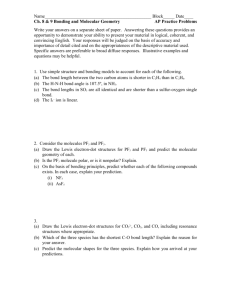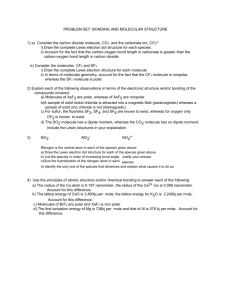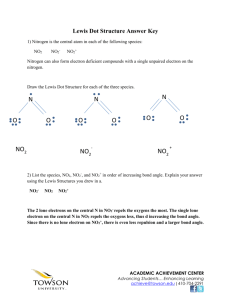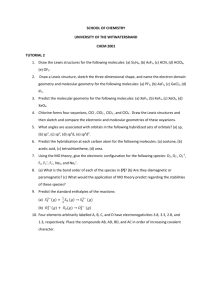Lewis Dot Structure Practice Problems
advertisement
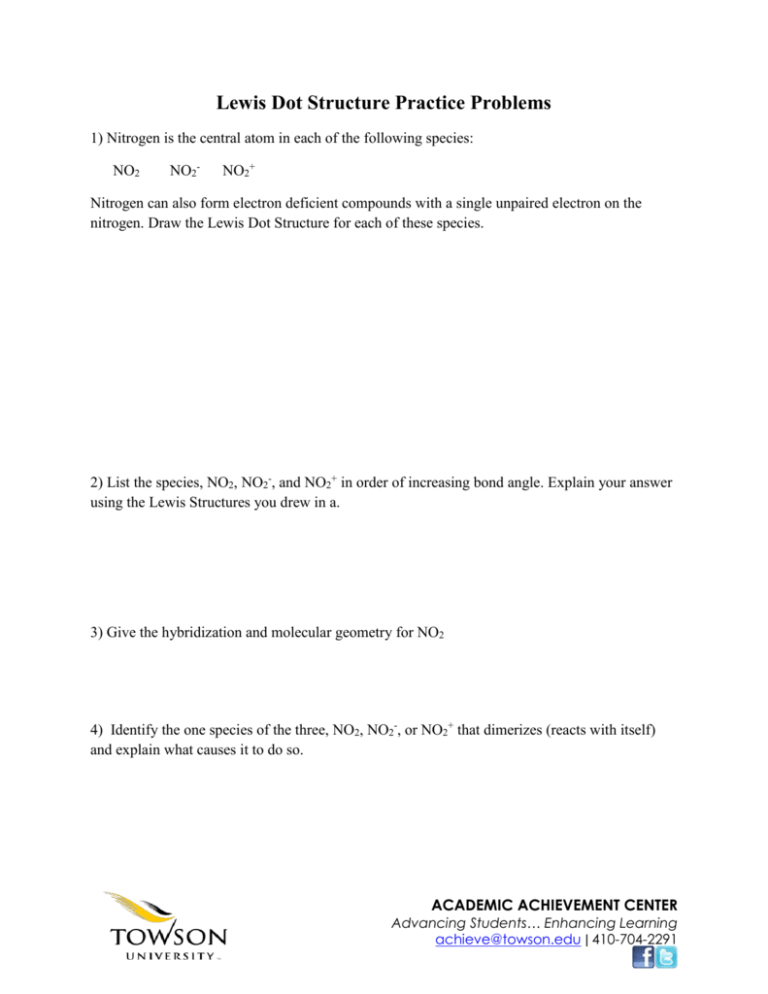
Lewis Dot Structure Practice Problems 1) Nitrogen is the central atom in each of the following species: NO2 NO2- NO2+ Nitrogen can also form electron deficient compounds with a single unpaired electron on the nitrogen. Draw the Lewis Dot Structure for each of these species. 2) List the species, NO2, NO2-, and NO2+ in order of increasing bond angle. Explain your answer using the Lewis Structures you drew in a. 3) Give the hybridization and molecular geometry for NO2 4) Identify the one species of the three, NO2, NO2-, or NO2+ that dimerizes (reacts with itself) and explain what causes it to do so. ACADEMIC ACHIEVEMENT CENTER Advancing Students… Enhancing Learning achieve@towson.edu ǀ 410-704-2291 5) Use the principles of bonding to explain the following statement: Phosphorous forms the fluorides PF3 and PF5, whereas nitrogen only forms NF3. 6) Use the principles of bonding to explain the following statement: The SO2 molecule has a dipole moment, whereas the CO2 molecule has no dipole moment 7) Use the principles of bonding to explain the following statement: Molecules of AsF3 are polar, whereas the molecules of AsF5 are nonpolar. 8) Use the principles of bonding to explain the following statement: The N--O bonds in NO2- are equal in length, whereas they are unequal in HNO2. 9) Use the principles of bonding to explain the following statement: For sulfur, the fluorides SF2, SF4, and SF6 are known to exist, whereas for oxygen only OF2 is known to exist. ACADEMIC ACHIEVEMENT CENTER Advancing Students… Enhancing Learning achieve@towson.edu ǀ 410-704-2291 10) Consider the carbon dioxide molecule, CO2, and the carbonate ion, CO32Draw the Lewis Structure for each. 11) The molecular geometry of CO2 is 12) The molecular geometry of CO32- is 13) Account for the fact that the carbon oxygen bond length in CO3 2- is greater than the carbon oxygen bond length in CO2 14) Consider the molecules CF4 and SF4 Draw the Lewis Structure for each molecule. 15) The molecular geometry of CF4 is 16) The molecular geometry of SF4 is ACADEMIC ACHIEVEMENT CENTER Advancing Students… Enhancing Learning achieve@towson.edu ǀ 410-704-2291 17) Account for the fact that CF4 is nonpolar while SF4 is polar 18) Compare and contrast the three major models (ionic, covalent, and metallic) for bonding. (Hint: What happens to the electrons?) 19) What are isoelectronic ions? Use electronic configurations to show that S2-, K+, and Ti4+ are isoelectronic. List the three ions in order of INCREASING size. 20) Describe one property of metals. Use the electron sea model to account for this property. 21) Compare and contrast the physical properties of ionic and covalent compounds. ACADEMIC ACHIEVEMENT CENTER Advancing Students… Enhancing Learning achieve@towson.edu ǀ 410-704-2291


